The MGA With An Attitude
CRANKCASE VENTILATION for the Twin Cam #4 - TC-335D
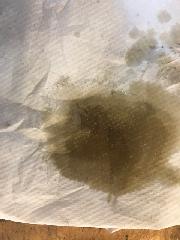 On 4/30/2020, Luc Van Helleputte - wrote:
On 4/30/2020, Luc Van Helleputte - wrote:
"There was a lot off discussion about the cam cover breather system. I did a small test and removed the oil filler cap and let run the engine for 30 sec at 1500 rpm, and thatís the result. Their is a positive air pressure. When you put the filter in place off the oil filler cap, itís clear that due to all the oil being thrown off by the chain, the filter will get clogged.
 So I was thinking about a better solution together with my friend Dirk. He made for me 2 undercut studs 5/16 UNC and 5/16 UNF. Where the stud passes through the cam cover it is reduced to 4.5mm; the hole in the cam covers is 8,5mm. This way the air can pass through the two small towers bolted on the covers. So I was thinking about a better solution together with my friend Dirk. He made for me 2 undercut studs 5/16 UNC and 5/16 UNF. Where the stud passes through the cam cover it is reduced to 4.5mm; the hole in the cam covers is 8,5mm. This way the air can pass through the two small towers bolted on the covers.
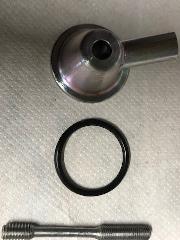
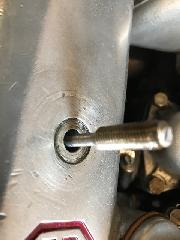
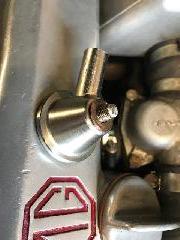
I used this type off breathing. This is the result. I used a "oil catch can" with 2 entries and a air filter (breaker) on top. And now the complete result".
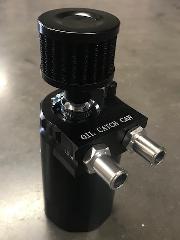

Notes from Barney:
It is not clear (yet) that so much oil would be thrown up to bother an intake air filter on the oil filler cap. The hidden vent tube for the filler cap intake filter is relatively small, so it "should" not allow oil to intrude into the filter. There have by now been a few of these installed (as shown in prior pages), but maybe not enough running time yet to verify the desired results.
There must be a part number for the commercially available breather fittings. I will check into that, as well as the oil catch can assembly (optional for racing regulations). The special machined down threaded studs could be avoided if you didn't mind drilling a larger vent hole in the valve cover. Then you just need a longer standard stud.
Form follows function, and beauty is in the eye of the beholder. I like the concept, allowing filtered vent air to enter both valve covers. I presume this retains the original draft pipe on the rear tappet cover, and may also benefit by addition of a second draft pipe on the front tappet cover. For racing application where regulations may prohibit the open draft pipe, you might plug or delete the draft pipe(s). The oil catch can would then be mandatory rather than optional, being an exit vent rather than intake vent. This would once again defeat crankcase ventilation, but it is common for a race car when you change the oil fairly often.
There is another idea for a "dripless" engine. Delete the draft pipe(s) by blanking off the tappet covers on side ofthe engine block. Run one valve cover vent to a restricted intake filter. Run the other valve cover vent through a PCV valve to the intake manifold. Vent air would then enter one valve cover and exit the other one. This would give you Positive Crankcase Ventilation similar to 1964 and later MGB with slight vacuum in the crankcase, and blow-by fumes being routed to engine intake to be incinerated.
 This also begs for a change of fuel metering needles in the carburetors to provide a bit more fuel to mix with the small amount of vent air coming though the crankcase (especially at low engine speed). Blow-by gasses do not need additional fuel, as blow-by gas is inert with very little oxygen, so it doesn't screw up intake fuel/air ratio. That is more in the nature of Exhaust Gas Recirculation. This also begs for a change of fuel metering needles in the carburetors to provide a bit more fuel to mix with the small amount of vent air coming though the crankcase (especially at low engine speed). Blow-by gasses do not need additional fuel, as blow-by gas is inert with very little oxygen, so it doesn't screw up intake fuel/air ratio. That is more in the nature of Exhaust Gas Recirculation.
 See next page for a PCV set up including the oil catch can. See next page for a PCV set up including the oil catch can.
|